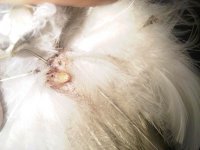A
You are using an out of date browser. It may not display this or other websites correctly.
You should upgrade or use an alternative browser.
You should upgrade or use an alternative browser.
mightymohan
New member
- Joined
- May 30, 2010
- Messages
- 109
- Reaction score
- 0
no idea what it is but they all have one.
foxy
Active member
It's a preening gland 
tygrysek75
Member
Just to add;
preen gland, also called Uropygial, or Oil, Gland, in birds, an organ located on the back near the base of the tail. Paired or in two united halves, it is found in most birds. Absent in ostrich, emu, cassowary, bustard, frogmouth, and a few other birds, the oil gland is best-developed in aquatic species, notably petrels and pelicans, and in the osprey and oilbird.
The secretions of the preen gland empty to the skin surface through one or more nipplelike pores. Most birds preen by rubbing their bill and head over the preen gland pore and then rubbing the accumulated oil over the feathers of the body and wings and the skin of the legs and feet. The oil is thought to help preserve the integrity of feather structure and, in some species, is also believed to be useful in preserving the horny structure of the bill and the scales of the legs and feet. It has also been speculated that, in at least some species, the oil contains a substance that is a precursor of vitamin D. This precursor substance is thought to be converted to vitamin D by the action of sunlight and then absorbed through the skin. Many ornithologists maintain that the function of the preen gland differs among various species of birds.
preen gland, also called Uropygial, or Oil, Gland, in birds, an organ located on the back near the base of the tail. Paired or in two united halves, it is found in most birds. Absent in ostrich, emu, cassowary, bustard, frogmouth, and a few other birds, the oil gland is best-developed in aquatic species, notably petrels and pelicans, and in the osprey and oilbird.
The secretions of the preen gland empty to the skin surface through one or more nipplelike pores. Most birds preen by rubbing their bill and head over the preen gland pore and then rubbing the accumulated oil over the feathers of the body and wings and the skin of the legs and feet. The oil is thought to help preserve the integrity of feather structure and, in some species, is also believed to be useful in preserving the horny structure of the bill and the scales of the legs and feet. It has also been speculated that, in at least some species, the oil contains a substance that is a precursor of vitamin D. This precursor substance is thought to be converted to vitamin D by the action of sunlight and then absorbed through the skin. Many ornithologists maintain that the function of the preen gland differs among various species of birds.
chrismahon
Well-known member
Very comprehensive answer Tygrysek75.
Shaunm41 -you will see her rub her beak on it to pick up some oil before and during preening. Oil leaks onto the immediately surrounding feathers and they get dust stuck to them which is only noticeable on light coloured birds. Chickens don't produce much oil from that gland which is why they get very wet in the rain, as opposed to ducks.
Shaunm41 -you will see her rub her beak on it to pick up some oil before and during preening. Oil leaks onto the immediately surrounding feathers and they get dust stuck to them which is only noticeable on light coloured birds. Chickens don't produce much oil from that gland which is why they get very wet in the rain, as opposed to ducks.
Well, you learn something new every day.....
Latest posts
-
What is your favorite breed of poultry ?
- Latest: CherishedFowlGuardian
-
-
-
-
-
-
-
-
-
-
-

